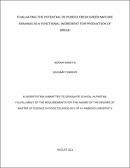| dc.description.abstract | The nutritional value of green mature cooking bananas is mainly attributed to their resistant
starch and dietary fibre content. This study aimed at developing bread using a composite
mixture of wheat (70%) and pureed fresh green mature cooking bananas (30%) purposely to
enhance its health benefits attributable to improved resistant starch and dietary fibre content,
and to reduce postharvest banana losses which currently stand at 40% in Uganda.
Eight treatments of wheat-banana composite bread were formulated as: (1) pureed fresh
whole Mpologoma fingers, (2) pureed fresh Mpologoma pulp, (3) whole Mpologoma flour,
(4) Mpologoma pulp flour, (5) pureed fresh whole N23 fingers, (6) pureed fresh N23 pulp, (7)
whole N23 flour and (8) N23 pulp flour. Bread made from 100% wheat was used as the
control. Alveograph and consistograph properties for each of the composite doughs were
determined. Resultant bread was baked using the straight dough method, and analysed for
physical attributes, as well as moisture, resistant starch and dietary fibre content using
standard methods. All bread samples were assessed for sensory acceptability on a 9-point
hedonic scale using 30 untrained panellists. The effect of addition of different forms (pureed
fresh vs flour) and varieties of bananas on dough rheology and bread quality characteristics
was evaluated by principal component analysis using XLSTAT software.
Addition of pureed fresh and/or powdered bananas increased the mixing time required to
reach maximum dough consistency. Mpologoma variety mostly increased the water
absorption capacity of the composite mixture in pureed fresh and flour forms compared with
other treatments, as it increased the amount of water needed for optimum dough production.
Addition of bananas to wheat flour also reduced resistance to deformation (prmax) resulting
in poor dough handling behaviour and low dough tolerance in the fermentation stage.
Whereas all composite doughs generally had poor alveograph profiles suggesting low
potential for using bananas in bread production, Mpologoma pureed fresh whole fingers had
better rheological properties than all other composite samples highlighting its potential for
application in the bread making process up to a (30%) substitution level. Additionally, dough
samples containing bananas exhibited lower baking strength and resistance to mechanical
mixing compared to the control indicating that the former were weaker doughs.
The general appearance of bread obtained from banana-wheat composite doughs was
appealing and comparable to that of the wheat alone control. High-quality bread was obtained
from each of the treatments including pureed fresh or flour, whole fingers or pulp and
different varieties which was contrary to alveographic and consistographic prediction data.
Loaf volume ranged from 1137.97 cm3 to 14 10.00 cm3 in samples formulated from 30% N23
pureed fresh pulp and 30% N23 pureed fresh whole fingers, respectively. There was general
increase in baking loss for bread formulated with banana flour compared with that made using
pureed fresh bananas. Bread samples containing 30% Mpologoma pureed fresh pulp had the
highest cross-sectional area while that from 30% N23 hybrid whole finger flour had the
lowest. Loaf weight was highest in the 30% Mpologoma pulp flour (613.50 g), and lowest in
the sample containing 30% N23 whole finger flour (544.00g). Crust and crumb browning
increased with the addition of 30% bananas in comparison to the control. Composite bread
exhibited reduced hardness, cohesiveness and adhesiveness compared to the control. Bread
formulated using Mpologoma had highest moisture content while that made using N23 hybrid
had the lowest. Overall, Mpologoma variety had higher contribution to resistant starch of the
bread than the N23 hybrid, irrespective of pureed fresh or flour forms. Bread formulated from
whole bananas had higher dietary fibre content than that made from banana pulp. Mpologoma
whole fingers had the highest contribution to dietary fibre content of bread compared to all
other treatments. Addition of bananas caused significant decrease in the sensory quality
attributes of the composite breads compared to the control. Interestingly, bread made from
50% pureed fresh Mpologoma whole fingers was more appreciated for its general appearance
close to that of the control. The blend of 30% Mpologoma pulp flour was most appreciated for
colour. Bread texture generally hardened whereas flavour and taste decreased with the
addition of bananas. It was therefore concluded that Mpologoma and N23 bananas could be
added at a rate of 30-50% in pureed fresh or flour forms to formulate bread with high resistant
starch and dietary fibre content. Addition of 30% banana pulp flour produced the best
composite bread in terms of taste and flavour, irrespective of variety, and could have better
prospects for commercial application compared with other treatments. | en_US |

